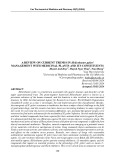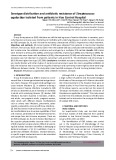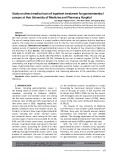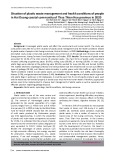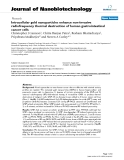
Human gastrointestinal
-
Helicobacter pylori is a bacterium associated with gastric diseases and disorders of the upper gastrointestinal tract. The gram-negative bacterium Helicobacter pylori is known as a persistent colonizer of the human stomach, and this bacteria is also involved in extra-intestinal diseases. In 1994, the International Agency for Research on Cancer, World Health Organization classified H. pylori as a class 1 carcinogen, the only bacterium given this classification.
 11p
11p  vinara
vinara
 11-01-2025
11-01-2025
 1
1
 1
1
 Download
Download
-
Group B streptococcus (GBS) infections are still the leading cause of invasive infections in neonates, specically they also seriously cause mortality and morbidity with underlying diseases in adults. Curently, there are ten GBS serotypes (Ia, Ib, and II-IX) and the resistance characteristic of GBS is important to clinical treatment.
 5p
5p  viharuno
viharuno
 03-01-2025
03-01-2025
 5
5
 2
2
 Download
Download
-
Gastrointestinal cancers, including liver cancer, colorectal cancer, and stomach cancer, are the most common cancers in the world as well as in Vietnam, posing a leading threat to human health. The cost of treating these cancers is a major problem that burdens not only patients but also healthcare systems. The study aims to analyze treatment costs for the four most common types of gastrointestinal cancer nowadays.
 9p
9p  viharuno
viharuno
 03-01-2025
03-01-2025
 4
4
 2
2
 Download
Download
-
Unmanaged plastic waste will affect the environment and human health. The study was conducted to describe the current situation of plastic waste management and the health conditions related to plastic waste of people in Hai Duong commune, Central Vietnam, in 2020.
 7p
7p  viharuno
viharuno
 03-01-2025
03-01-2025
 3
3
 2
2
 Download
Download
-
This Master by Research project aims to develop the human gas capsule that enables realtime intestinal gas profiling in a low-cost, non-invasive and accurate manner. The safety, viability, reliability and repeatability of the capsule will be evaluated in both laboratorial environments and animal trials that are influenced by dietary effect, heat-stress-induced gut disorder and dietary supplemental therapeutic agent.
 104p
104p  runthenight04
runthenight04
 02-02-2023
02-02-2023
 8
8
 3
3
 Download
Download
-
Tuyển tập báo cáo các nghiên cứu khoa học quốc tế ngành y học dành cho các bạn tham khảo đề tài: Intracellular gold nanoparticles enhance non-invasive radiofrequency thermal destruction of human gastrointestinal cancer cells
 9p
9p  toshiba25
toshiba25
 08-12-2011
08-12-2011
 57
57
 6
6
 Download
Download
CHỦ ĐỀ BẠN MUỐN TÌM








